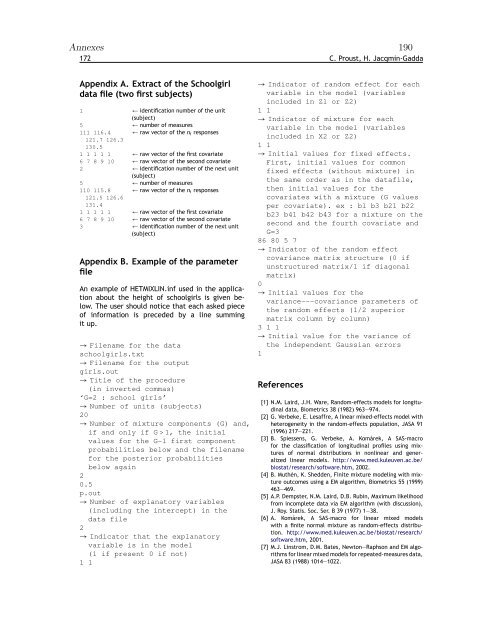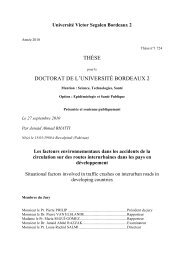Annexes 190172 C. Proust, H. Jacqmin-GaddaAppendix A. Extract of the Schoolgirldata fi<strong>le</strong> (two first subjects)1 ← identification number of the unit(subject)5 ← number of measures111 116.4 ← raw vector of the n i responses121.7 126.3130.51 1 1 1 1 ← raw vector of the first covariate6 7 8 9 10 ← raw vector of the second covariate2 ← identification number of the next unit(subject)5 ← number of measures110 115.8 ← raw vector of the n i responses121.5 126.6131.41 1 1 1 1 ← raw vector of the first covariate6 7 8 9 10 ← raw vector of the second covariate3 ← identification number of the next unit(subject)Appendix B. Examp<strong>le</strong> of the parameterfi<strong>le</strong>An examp<strong>le</strong> of HETMIXLIN.inf used in the applicationabout the height of schoolgirls is given below.The user should notice that each asked pieceof information is preceded by a line summingit up.→ Fi<strong>le</strong>name for the dataschoolgirls.txt→ Fi<strong>le</strong>name for the outputgirls.out→ Tit<strong>le</strong> of the procedure(in inverted commas)‘G=2 : school girls’→ Number of units (subjects)20→ Number of mixture components (G) and,if and only if G > 1, the initialvalues for the G-1 first componentprobabilities below and the fi<strong>le</strong>namefor the posterior probabilitiesbelow again20.5p.out→ Number of explanatory variab<strong>le</strong>s(including the intercept) in thedata fi<strong>le</strong>2→ Indicator that the explanatoryvariab<strong>le</strong> is in the model(1 if present 0 if not)1 1→ Indicator of random effect for eachvariab<strong>le</strong> in the model (variab<strong>le</strong>sincluded in Z1 or Z2)1 1→ Indicator of mixture for eachvariab<strong>le</strong> in the model (variab<strong>le</strong>sincluded in X2 or Z2)1 1→ Initial values for fixed effects.First, initial values for commonfixed effects (without mixture) inthe same order as in the datafi<strong>le</strong>,then initial values for thecovariates with a mixture (G valuesper covariate). ex : b1 b3 b21 b22b23 b41 b42 b43 for a mixture on thesecond and the fourth covariate andG=386 80 5 7→ Indicator of the random effectcovariance matrix structure (0 ifunstructured matrix/1 if diagonalmatrix)0→ Initial values for thevariance---covariance parameters ofthe random effects (1/2 superiormatrix column by column)3 1 1→ Initial value for the variance ofthe independent Gaussian errors1References[1] N.M. Laird, J.H. Ware, Random-effects models for longitudinaldata, Biometrics 38 (1982) 963—974.[2] G. Verbeke, E. Lesaffre, A linear mixed-effects model withheterogeneity in the random-effects population, JASA 91(1996) 217—221.[3] B. Spiessens, G. Verbeke, A. Komárek, A SAS-macrofor the classification of longitudinal profi<strong>le</strong>s using mixturesof normal distributions in nonlinear and generalizedlinear models. http://www.med.ku<strong>le</strong>uven.ac.be/biostat/research/software.htm, 2002.[4] B. Muthén, K. Shedden, Finite mixture modeling with mixtureoutcomes using a EM algorithm, Biometrics 55 (1999)463—469.[5] A.P. Dempster, N.M. Laird, D.B. Rubin, Maximum likelihoodfrom incomp<strong>le</strong>te data via EM algorithm (with discussion),J. Roy. Statis. Soc. Ser. B 39 (1977) 1—38.[6] A. Komárek, A SAS-macro for linear mixed modelswith a finite normal mixture as random-effects distribution.http://www.med.ku<strong>le</strong>uven.ac.be/biostat/research/software.htm, 2001.[7] M.J. Linstrom, D.M. Bates, Newton—Raphson and EM algorithmsfor linear mixed models for repeated-measures data,JASA 83 (1988) 1014—1022.
Annexes 191Estimation of linear mixed models with a mixture of distribution for the random effects 173[8] R.A. Redner, H.F. Walker, Mixture densities, maximum likelihoodand the EM algorithm, SIAM Rev. 26 (1984) 195—239.[9] D. Marquardt, An algorithm for <strong>le</strong>ast-squares estimation ofnonlinear parameters, SIAM J. Appl. Math. 11 (1963) 431—441.[10] R. F<strong>le</strong>tcher, Practical Methods of Optimization, second ed.,John Wi<strong>le</strong>y & Sons, 2000 (Chapter 3).[11] K. Knight, Mathematical Statistics, Chapman & Hall/CRC,2000 (Chapters 3 and 5).[12] D. Karlis, E. Xekalaki, Choosing initial values for the EMalgorithm for finite mixtures, Comput. Statist. Data Anal.41 (2003) 577—590.[13] P. Schlattmann, Estimating the number of components ina finite mixture model: the special case of homogeneity,Comput. Statist. Data Anal. 41 (2003) 441—451.[14] H. Akaike, A new look at the statistical model identification,IEEE Trans. Automat. Control 19 (1974) 716—723.[15] G. Schwarz, Estimating the dimension of a model, Ann.Stat. 6 (1978) 461—464.[16] H. Goldstein, The Design and Analysis of Longitudinal Studies,Academic Press, London, 1979.[17] G.J. McLachlan, T. Krishnan, The EM Algorithm and Extensions,John Wi<strong>le</strong>y & Sons, 1997.[18] T.A. Louis, Finding the Observed Information Matrix whenUsing the EM algorithm, J. Roy. Statis. Soc. Ser. B 44 (1982)226—233.[19] L. Letenneur, D. Commenges, J.F. Dartigues, P. Barberger-Gateau, Incidence of dementia and Alzheimer’s disease inelderly community residents of south-western France, Int.J. Epidemiol. 23 (1994) 1256—1261.[20] H. Jacqmin-Gadda, C. Fabrigou<strong>le</strong>, D. Commenges, J.F. Dartigues,A 5-year longitudinal study of the Mini Mental StateExamination in normal aging, Am. J. Epidemiol. 145 (1997)498—506.[21] L. Letenneur, V. Gil<strong>le</strong>ron, D. Commenges, C. Helmer, J.M.Orgogozo, J.F. Dartigues, Are sex and educational <strong>le</strong>vel independentpredictors of dementia and Alzheimer’s disease?Incidence data from the PAQUID project, J. Neurol. Neurosurg.Psychiatr. 66 (1999) 177—183.
- Page 1 and 2:
Université Victor Segalen Bordeaux
- Page 3 and 4:
3RemerciementsA Monsieur Jean-Louis
- Page 5 and 6:
5Un immense merci à tous ceux que
- Page 7 and 8:
7A Delphine et ses mille et une his
- Page 9 and 10:
TABLE DES MATIÈRES 92.3.2 Estimati
- Page 11 and 12:
TABLE DES MATIÈRES 116.3.1 Adéqua
- Page 13 and 14:
Introduction 13ans atteintes d’un
- Page 15 and 16:
Introduction 15Mais, pour l’insta
- Page 17 and 18:
Introduction 171.2 Problèmes méth
- Page 19 and 20:
Introduction 191.2.3 Association en
- Page 21 and 22:
Introduction 21QUID suggère que le
- Page 23 and 24:
Chapitre 2Etat des connaissancesCe
- Page 25 and 26:
Etat des connaissances 25Plusieurs
- Page 27 and 28:
Etat des connaissances 27Prise en c
- Page 29 and 30:
Etat des connaissances 29Extensions
- Page 31 and 32:
Etat des connaissances 31données s
- Page 33 and 34:
Etat des connaissances 33variables
- Page 35 and 36:
Etat des connaissances 35(2000) ne
- Page 37 and 38:
Etat des connaissances 372.3 Modél
- Page 39 and 40:
Etat des connaissances 39chapitre 3
- Page 41 and 42:
Etat des connaissances 41de mélang
- Page 43 and 44:
Etat des connaissances 43Hawkins et
- Page 45 and 46:
Etat des connaissances 45tique de d
- Page 47 and 48:
Etat des connaissances 47L’estima
- Page 49 and 50:
Etat des connaissances 49normales s
- Page 51 and 52:
Etat des connaissances 512.4 Modél
- Page 53 and 54:
Etat des connaissances 53en tant qu
- Page 55 and 56:
Etat des connaissances 55interactio
- Page 57 and 58:
Etat des connaissances 57décrite p
- Page 59 and 60:
Etat des connaissances 59entre l’
- Page 61 and 62:
Etat des connaissances 612.4.3 Cas
- Page 63 and 64:
Etat des connaissances 63l’inform
- Page 65 and 66:
Modèle nonlinéaire à processus l
- Page 67 and 68:
Modèle nonlinéaire à processus l
- Page 69 and 70:
Modèle nonlinéaire à processus l
- Page 71 and 72:
Modèle nonlinéaire à processus l
- Page 73 and 74:
Modèle nonlinéaire à processus l
- Page 75 and 76:
Modèle nonlinéaire à processus l
- Page 77 and 78:
Modèle nonlinéaire à processus l
- Page 79 and 80:
Modèle nonlinéaire à processus l
- Page 81 and 82:
Modèle nonlinéaire à processus l
- Page 83 and 84:
Modèle nonlinéaire à processus l
- Page 85 and 86:
Modèle nonlinéaire à processus l
- Page 87 and 88:
Modèle nonlinéaire à processus l
- Page 89 and 90:
Modèle nonlinéaire à processus l
- Page 91 and 92:
Modèle nonlinéaire à processus l
- Page 93 and 94:
Chapitre 4Modèle nonlinéaire à c
- Page 95 and 96:
Modèle nonlinéaire à classes lat
- Page 97 and 98:
Modèle nonlinéaire à classes lat
- Page 99 and 100:
Modèle nonlinéaire à classes lat
- Page 101 and 102:
Modèle nonlinéaire à classes lat
- Page 103 and 104:
Modèle nonlinéaire à classes lat
- Page 105 and 106:
Modèle nonlinéaire à classes lat
- Page 107 and 108:
Modèle nonlinéaire à classes lat
- Page 109 and 110:
Modèle nonlinéaire à classes lat
- Page 111 and 112:
Modèle nonlinéaire à classes lat
- Page 113 and 114:
Modèle nonlinéaire à classes lat
- Page 115 and 116:
Modèle nonlinéaire à classes lat
- Page 117 and 118:
Modèle nonlinéaire à classes lat
- Page 119 and 120:
Modèle nonlinéaire à classes lat
- Page 121 and 122:
Modèle nonlinéaire à classes lat
- Page 123 and 124:
Modèle nonlinéaire à classes lat
- Page 125 and 126:
Modèle nonlinéaire à classes lat
- Page 127 and 128:
Modèle nonlinéaire à classes lat
- Page 129 and 130:
Modèle nonlinéaire à classes lat
- Page 131 and 132:
Modèle nonlinéaire à classes lat
- Page 133 and 134:
Modèle nonlinéaire à classes lat
- Page 135 and 136:
Modèle nonlinéaire à classes lat
- Page 137 and 138:
Modèle nonlinéaire à classes lat
- Page 139 and 140: Modèle nonlinéaire à classes lat
- Page 141 and 142: Modèle nonlinéaire à classes lat
- Page 143 and 144: Modèle nonlinéaire à classes lat
- Page 145 and 146: Modèle nonlinéaire à classes lat
- Page 147 and 148: Modèle nonlinéaire à classes lat
- Page 149 and 150: Chapitre 6Discussion et perspective
- Page 151 and 152: Discussion et perspectives 151la pr
- Page 153 and 154: Discussion et perspectives 153Varia
- Page 155 and 156: Discussion et perspectives 1556.2 M
- Page 157 and 158: Discussion et perspectives 157à cl
- Page 160 and 161: Discussion et perspectives 160effet
- Page 162 and 163: Discussion et perspectives 162Dans
- Page 164 and 165: Chapitre 7BibliographieAmieva, H.,
- Page 166 and 167: Bibliographie 1661, S19-25.Brown, E
- Page 168 and 169: Bibliographie 168Sons, New-York.Fol
- Page 170 and 171: Bibliographie 170Hogan, J. W. et La
- Page 172 and 173: Bibliographie 172Lin, H., McCulloch
- Page 174 and 175: Bibliographie 174Park, CA.Muthén,
- Page 176 and 177: Bibliographie 176Schlattmann, P. (2
- Page 178 and 179: Bibliographie 178in the random-effe
- Page 180 and 181: Chapitre 8Annexes8.1 Liste des publ
- Page 182 and 183: Annexes 182Pau (France)Communicatio
- Page 184 and 185: Annexes 184166 C. Proust, H. Jacqmi
- Page 186 and 187: Annexes 186168 C. Proust, H. Jacqmi
- Page 188 and 189: Annexes 188170 C. Proust, H. Jacqmi
- Page 192 and 193: AnnexesAmerican Journal of Epidemio
- Page 194 and 195: Annexes 194Psychometric Tests’ Se
- Page 196 and 197: Annexes 196Psychometric Tests’ Se
- Page 198 and 199: Annexes 198Psychometric Tests’ Se
- Page 200 and 201: Annexes 200Abstract :When investiga
- Page 202 and 203: Annexes 202educated subjects. This
- Page 204 and 205: Annexes 204(iii) the recognition fo
- Page 206 and 207: Annexes 206Explanatory variablesIn
- Page 208 and 209: Annexes 208IST15 (median=28, IQR=24
- Page 210 and 211: Annexes 210and on the mean evolutio
- Page 212 and 213: Annexes 212These findings should be
- Page 214 and 215: Annexes 214Appendix : model specifi
- Page 216 and 217: Annexes 216References[1] Amieva H,
- Page 218 and 219: Annexes 218[19] Letenneur L, Commen
- Page 220 and 221: Annexes 220Figure 1 : (A) Predicted
- Page 222 and 223: Annexes 222Table 1: demographic and
- Page 224: Annexes 224MMSE 0.0037 * 0.0013,0.0
















